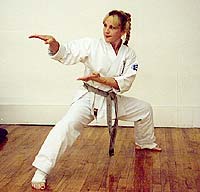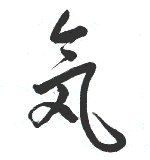Kata, Bunkai & Calligraphy
By George Donahue
 It
has often been asked if applications should be practiced outside karate
kata exactly as they are performed in the kata, or whether they should
be modified to meet variations in the situation. Kata are sequential performances
of prearranged techniques passed on from teacher to students. For centuries
they have been a central teaching method of karate and they reveal not
only function and application, but spirit and some say "secrets"
as well. Thus, the question is an important one, since it affects the
very heritage and understanding of karate itself. It
has often been asked if applications should be practiced outside karate
kata exactly as they are performed in the kata, or whether they should
be modified to meet variations in the situation. Kata are sequential performances
of prearranged techniques passed on from teacher to students. For centuries
they have been a central teaching method of karate and they reveal not
only function and application, but spirit and some say "secrets"
as well. Thus, the question is an important one, since it affects the
very heritage and understanding of karate itself.
Chotoku Omine-sensei (who was the head of Matsubayashi Ryu in the Americas)
once told me that he regarded kata as the skeletal structure of karate.
According to this generous and great Okinawan teacher (dead some twenty
years now, unfortunately), kata practiced with strict dedication makes
strong karate bones (mental, more than physical), but bones alone can't
do much. The art comes with how you refine and define the musculature
that surrounds the skeleton and how you strengthen and refine the mind
that moves the muscles that move the bones that you've made strong. We
can regard kata as the optimal expression of a movement or technique,
but we can also regard kata as the foundation from which the real expression
of karate technique builds upward and outward and inward. Both points
of view are constructive, but some moves in some of the kata are executed
purposely from less than optimal circumstances.
Another teacher who has made a significant contribution to my development,
Takayoshi Nagamine-sensei (who has succeeded his father, Shoshin Nagamine,
as the head of Matsubayashi Ryu), told me that every kata is a riddle
and that every visible move hides the truly important invisible or "hidden"
move or application (called bunkai in Japanese). The kata that we see
is the "me kata" ("me" is a Japanese word for "eye")
that occupies the eye while the real stuff goes on just below the level
that we can register with our conscious mind. This teacher's own teacher,
Seigi Nakamura, with whom I studied for a short while, too, had rebuked
him by saying that referring to a move as a "hidden" move makes
it seem as though the moves are secret and are only given to the favored
few, when actually they are there for everyone to see, if they're willing
to use their eyes in an unfettered manner. Nakamura-sensei preferred to
call the "hidden" moves "intermediary" moves, because
they occur between the obvious-to-the-eye basic moves, and because they
are not exotic or special, but are just a little harder to catch. The
key to catching them, by the way, is to watch the koshi (pelvic carriage)
and hikite (pulling hand) carefully to penetrate the sleight of hand.
Yet another teacher, Katsuhiko Shinzato*, who has graciously served as
a personal mentor, uses the well-known analogy of comparing kata to calligraphy,
the art of writing kanji characters.
 The
first definable level on the continuum of kata performance is kaisho,
or character printing in a somewhat stiff block style. Beginners do their
kata this way, but so do advanced students when they're teaching beginners
or adhering to a standard of the ryu during group performances. Movements
are angular, thick, and well defined. "Hidden" moves are hidden
away for some other time or, in the case of beginners or the lazy, not
yet discovered. The
first definable level on the continuum of kata performance is kaisho,
or character printing in a somewhat stiff block style. Beginners do their
kata this way, but so do advanced students when they're teaching beginners
or adhering to a standard of the ryu during group performances. Movements
are angular, thick, and well defined. "Hidden" moves are hidden
away for some other time or, in the case of beginners or the lazy, not
yet discovered.
 The
next discrete level of performance is gyosho, or semicursive writing that
is not as stiff and more flowing. This is cursive writing like it's done
by school kids. The individual letters (movements) are joined together
with big loops and roundish patterns. The words are still very easy to
read, but there is now room for the intermediary techniques, too. Individuality
comes into play. Good black belts and exceptional brown belts perform
their kata in this manner. The
next discrete level of performance is gyosho, or semicursive writing that
is not as stiff and more flowing. This is cursive writing like it's done
by school kids. The individual letters (movements) are joined together
with big loops and roundish patterns. The words are still very easy to
read, but there is now room for the intermediary techniques, too. Individuality
comes into play. Good black belts and exceptional brown belts perform
their kata in this manner.
 The
highest discrete or definable level of performance is sosho (grass writing),
or cursive writing which is free flowing and that allows freedom of physical
and aesthetic expression. This is cursive writing as done by strong, mature
individuals. You can make out the words still, but the words are accompanied
by the poetry of the movement of the letters. The words should flow like
ripples in the prairie grass on a windy day. The grass talks at these
times, and so kata tells a story independent of and in addition to its
components when done this way. Corners are cut, strokes may be dropped,
but the flow is powerful. This is the level of performance of one who
is truly a master of the kata. You might not perform all kata at this
level, but usually mastery of any kata to this level means mastery of
all kata to this level. The
highest discrete or definable level of performance is sosho (grass writing),
or cursive writing which is free flowing and that allows freedom of physical
and aesthetic expression. This is cursive writing as done by strong, mature
individuals. You can make out the words still, but the words are accompanied
by the poetry of the movement of the letters. The words should flow like
ripples in the prairie grass on a windy day. The grass talks at these
times, and so kata tells a story independent of and in addition to its
components when done this way. Corners are cut, strokes may be dropped,
but the flow is powerful. This is the level of performance of one who
is truly a master of the kata. You might not perform all kata at this
level, but usually mastery of any kata to this level means mastery of
all kata to this level.
Of course, there's always scribbling, and I've seen and done a lot of
scribbled kata in my time.
Ultimately, we should be able to give birth to our techniques like a
tree sways when the wind blows. Or when you scratch an itch -- no thought.
Footnote:
* Shinzato-sensei subsequently wrote an article on this subject, which
has appeared in a Japanese martial arts magazine and an adaptation of
which is included in the "Big Blue" book of Shohei Ryu.]
About The Author:
George Donahue has been on the board of FightingArts.com
since its inception. He is a freelance writer and editor, providing literary
and consulting services to writers, literary agents, and publishers, as
well to advertising agencies. He has worked in publishing for more than
three decades, beginning as a journal and legal editor. Among his positions
have been editorial stints at Random House; Tuttle Publishing, where he
was the executive editor, martial arts editor, and Asian Studies editor;
and Lyons Press, where he was the senior acquisitions editor and where
he established a martial arts publishing program. He is a 6th dan student
of karate and kobujutsu—as well as Yamane Ryu Bojutsu—of Shinzato
Katsuhiko in Okinawa Karatedo Shorin Ryu Kishaba Juku. He was also a student
of Kishaba Chokei and Nakamura Seigi until their deaths. He teaches Kishaba
Juku in New York and Connecticut, as well as traveling to provide seminars
and special training in karate, weapons, and self-defense. His early training
was in judo and jujutsu, primarily with Ando Shunnosuke in Tokyo. He also
studied kyujutsu (archery), sojutsu (spear), and kenjutsu (swordsmanship)
in Japan as a youth. Following his move to the US, he continued to practice
judo and jujutsu, as well as marksmanship with bow and gun, and began
the study of Matsubayashi Ryu karate in his late teens. Subsequently,
he has studied aikido and taiji and cross trained in ying jow pai kung
fu.
Note: This article was edited by Wendy Hiester Gilbert (FightingArts
Copy Editor), developed from material supplied by George Donahue that
originally appeared as his answer to questions on the subject of kata
that appeared on the Karate Cyber Dojo in May of 1997.
|